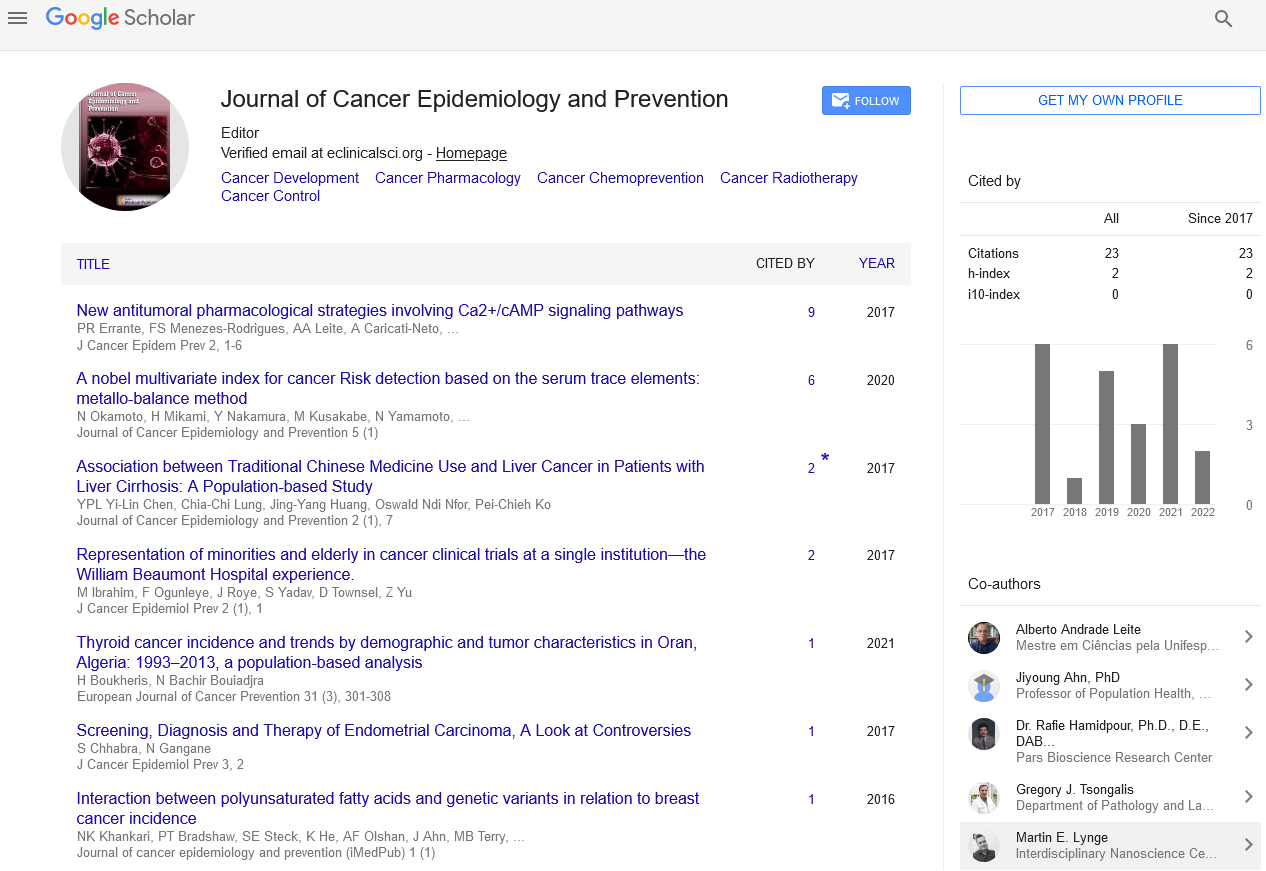Commentary - (2024) Volume 9, Issue 2
Cancer Surveillance: Monitoring, Prevention, and Advances in Early Detection
Jack Walker*
Department of Medical Epidemiology, Karolinska Institute, Sweden
*Correspondence:
Jack Walker,
Department of Medical Epidemiology, Karolinska Institute,
Sweden,
Email:
Received: 29-May-2024, Manuscript No. IPJCEP-24-20848;
Editor assigned: 31-May-2024, Pre QC No. IPJCEP-24-20848 (PQ);
Reviewed: 14-Jun-2024, QC No. IPJCEP-24-20848;
Revised: 19-Jun-2024, Manuscript No. IPJCEP-24-20848 (R);
Published:
26-Jun-2024, DOI: 10.36648/IPJCEP.9.2.16
Description
Cancer surveillance is a critical component of modern
healthcare systems worldwide, aimed at monitoring the
incidence, prevalence, and trends of cancer within populations.
Beyond mere observation, it encompasses a spectrum of
activities crucial for early detection, effective treatment, and
ongoing management of cancer cases. This article explores
the multifaceted aspects of cancer surveillance, highlighting its
importance, methodologies, challenges, and recent advances.
Cancer remains one of the leading causes of mortality
globally, with its incidence rising due to aging populations,
lifestyle changes, and environmental factors. Effective cancer
surveillance provides invaluable data for public health planning,
resource allocation, and policy formulation. By tracking trends
in cancer types, demographics, and geographical variations,
healthcare systems can tailor prevention strategies and
allocate resources where they are most needed. Central to
cancer surveillance is the systematic collection, analysis, and
reporting of cancer-related data. National cancer registries
play a pivotal role in this process, compiling information on
new cancer diagnoses, treatment outcomes, and survival rates.
These registries serve as repositories of epidemiological data,
facilitating research and informing public health initiatives.
Early detection is paramount in improving cancer outcomes.
Surveillance programs often include screening initiatives for
common cancers such as breast, colorectal, cervical, and
prostate cancers. Screening aims to identify pre-cancerous
lesions or early-stage cancers when treatment is most effective,
thereby reducing mortality and morbidity. Ensuring the
accuracy and reliability of surveillance data requires stringent
quality assurance measures. Standardization of data collection
methodologies, coding practices, and reporting criteria
enhances comparability across different regions and over time.
This standardization is crucial for identifying trends, evaluating
interventions, and benchmarking healthcare outcomes. Despite
its importance, cancer surveillance faces several challenges that
impact its effectiveness and scope. In some regions, incomplete
reporting of cancer cases and disparities in access to healthcare
services can lead to underestimation of cancer burden.
Integrating data from diverse sources-clinical records, pathology
reports, and population-based surveys-poses technical and
logistical challenges. Safeguarding patient confidentiality while
sharing data for research and public health purposes requires
robust ethical frameworks and legal protections. Limited
funding, especially in low-resource settings, can hamper the
establishment and maintenance of comprehensive cancer
surveillance systems. Recent advancements in technology have
significantly enhanced the capabilities of cancer surveillance.
Advances in genomic sequencing and molecular profiling allow
for personalized cancer surveillance. Genetic markers and
biomarkers can predict cancer risk, guide treatment decisions,
and monitor disease progression with greater precision.
Machine learning algorithms analyse vast amounts of imaging
and clinical data to improve cancer detection and diagnostic
accuracy. AI-powered tools can identify subtle patterns in
medical images, aiding radiologists in detecting tumours at
earlier stages. Liquid biopsies, which analyse Circulating Tumour
Cells (CTCs) or tumour-derived nucleic acids in blood samples,
offer a minimally invasive method for monitoring cancer
progression and treatment response. These assays provide
real-time information on tumour dynamics and molecular
changes. Telemedicine platforms enable remote consultations
and follow-ups, facilitating continuous monitoring of cancer
patients’ health status and adherence to treatment protocols.
Acknowledgement
None.
Conflict Of Interest
The author’s declared that they have no conflict of interest.
Citation: Walker J (2024) Cancer Surveillance: Monitoring, Prevention, and Advances in Early Detection. J Cancer Epidemiol Prev. 9:16.
Copyright: © 2024 Walker J. This is an open-access article distributed under the terms of the Creative Commons Attribution License, which permits unrestricted use, distribution, and reproduction in any medium, provided the original author and source are credited.

